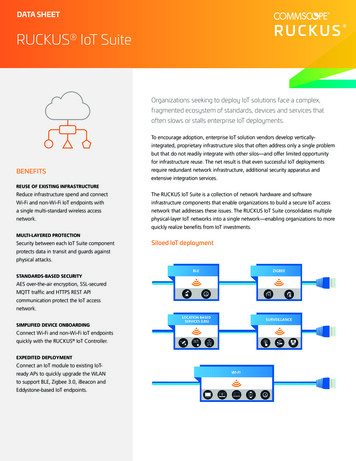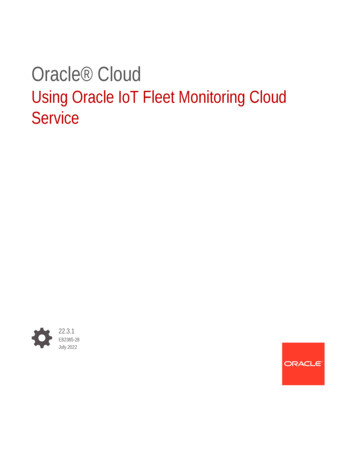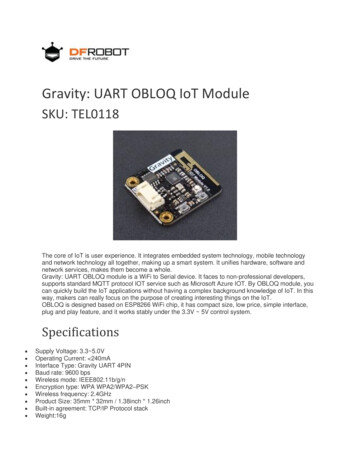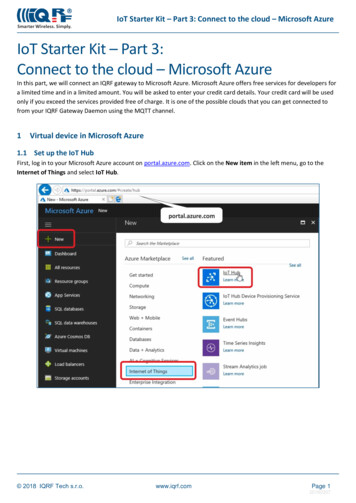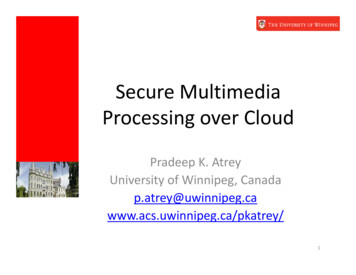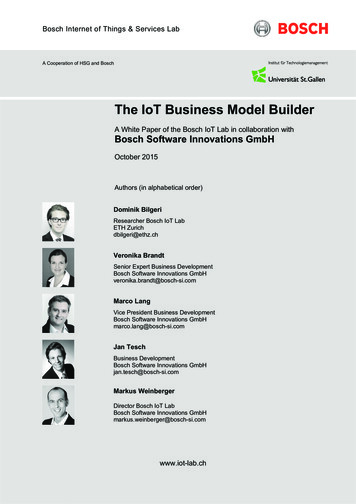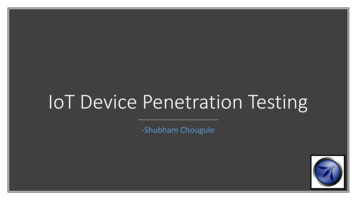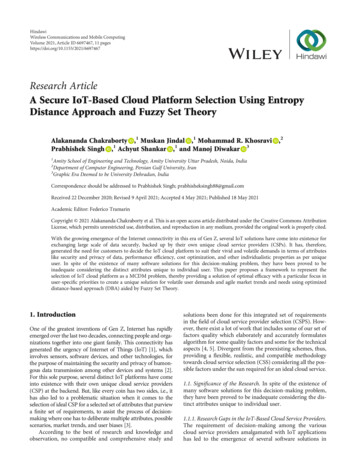
Transcription
HindawiWireless Communications and Mobile ComputingVolume 2021, Article ID 6697467, 11 pageshttps://doi.org/10.1155/2021/6697467Research ArticleA Secure IoT-Based Cloud Platform Selection Using EntropyDistance Approach and Fuzzy Set TheoryAlakananda Chakraborty ,1 Muskan Jindal ,1 Mohammad R. Khosravi ,2Prabhishek Singh ,1 Achyut Shankar ,1 and Manoj Diwakar 31Amity School of Engineering and Technology, Amity University Uttar Pradesh, Noida, IndiaDepartment of Computer Engineering, Persian Gulf University, Iran3Graphic Era Deemed to be University Dehradun, India2Correspondence should be addressed to Prabhishek Singh; prabhisheksingh88@gmail.comReceived 22 December 2020; Revised 9 April 2021; Accepted 4 May 2021; Published 18 May 2021Academic Editor: Federico TramarinCopyright 2021 Alakananda Chakraborty et al. This is an open access article distributed under the Creative Commons AttributionLicense, which permits unrestricted use, distribution, and reproduction in any medium, provided the original work is properly cited.With the growing emergence of the Internet connectivity in this era of Gen Z, several IoT solutions have come into existence forexchanging large scale of data securely, backed up by their own unique cloud service providers (CSPs). It has, therefore,generated the need for customers to decide the IoT cloud platform to suit their vivid and volatile demands in terms of attributeslike security and privacy of data, performance efficiency, cost optimization, and other individualistic properties as per uniqueuser. In spite of the existence of many software solutions for this decision-making problem, they have been proved to beinadequate considering the distinct attributes unique to individual user. This paper proposes a framework to represent theselection of IoT cloud platform as a MCDM problem, thereby providing a solution of optimal efficacy with a particular focus inuser-specific priorities to create a unique solution for volatile user demands and agile market trends and needs using optimizeddistance-based approach (DBA) aided by Fuzzy Set Theory.1. IntroductionOne of the greatest inventions of Gen Z, Internet has rapidlyemerged over the last two decades, connecting people and organizations together into one giant family. This connectivity hasgenerated the urgency of Internet of Things (IoT) [1], whichinvolves sensors, software devices, and other technologies, forthe purpose of maintaining the security and privacy of humongous data transmission among other devices and systems [2].For this sole purpose, several distinct IoT platforms have comeinto existence with their own unique cloud service providers(CSP) at the backend. But, like every coin has two sides, i.e., ithas also led to a problematic situation when it comes to theselection of ideal CSP for a selected set of attributes that purviewa finite set of requirements, to assist the process of decisionmaking where one has to deliberate multiple attributes, possiblescenarios, market trends, and user biases [3].According to the best of research and knowledge andobservation, no compatible and comprehensive study andsolutions been done for this integrated set of requirementsin the field of cloud service provider selection (CSPS). However, there exist a lot of work that includes some of our set offactors quality which elaborately and accurately formulatesalgorithm for some quality factors and some for the technicalaspects [4, 5]. Divergent from the preexisting schemes, thus,providing a flexible, realistic, and compatible methodologytowards cloud service selection (CSS) considering all the possible factors under the sun required for an ideal cloud service.1.1. Significance of the Research. In spite of the existence ofmany software solutions for this decision-making problem,they have been proved to be inadequate considering the distinct attributes unique to individual user.1.1.1. Research Gaps in the IoT-Based Cloud Service Providers.The requirement of decision-making among the variouscloud service providers amalgamated with IoT applicationshas led to the emergence of several software solutions in
2Wireless Communications and Mobile Computingrecent years. However, multiple demerits can be observed inthe performance and efficiency of these platforms [6]. Thecurrent short comings present in the IoT-based cloud serviceprovider solutions involve numerous dimensions includingthe inefficiency of the platforms to extend for supporting theheterogeneous sensing technologies. Other demerits includethe proprietorship of data, providing insinuations of privacyand security [7]. The processing and sharing of informationcan also be counted as another gap especially in scenarios whereit is essential to support novel services. The absence of assistanceprovided by application developers is another shortcomingfaced by several IoT cloud platforms [4]. Furthermore, mostof these IoT platforms do not possess the property of expansionfor the addition of new components to withstand the emergenceof new technologies and provide economies of scale. Lastly, thedelivery of the purchased software to the respective connecteddevices is also not supported by a majority of the marketplacesdedicated for IoT applications.Multicriteria Decision-Making (MCDM) techniques provide a scientific and easy solution. MCDM deals with organizing variegated attributes which come under the purview ofdecision-making. It specializes in handling issues where theproximity of attributes is close, and human cognitive abilitiesare not able to take the logical decisions. It does so by performing bargains or trade-offs by replacing one criterion by equivalent another. This paper presents an integrated set of factorsthat contribute the solution to the problematic issue of theselection of an optimal IoT cloud platform.In a nutshell, the qualities mentioned below make theproposed methodology novel when compared to state-ofthe-art techniques:(1) Identification and categorization of selection attributes (SA): after thorough and detailed studying ofmore than fifty research papers, few factors, i.e., selection attributes (SA) were filtered out. About 90 factors were carefully studied, and explicitly observedand relevant factors were mined out by removingredundant elements and those which were similarto each other. Finally, these factors were then categorized into broad three categories after extensive reasoning and filtration, namely,(i) Quality factors(ii) Technical factors(iii) Economic factors(2) Prioritization of identified selection factors (SA): theidentified selection attributes (SA) are then prioritized according to Fuzzy Set Theory. Here, prioritization is done on this basis of calculated priorityweights of each selection attribute individually(3) Development of a hybrid decision-making framework: once the selection attributes are successfullyselected and filtered out and then weighed, respectively, then the hybrid decision-making frameworkis developed using mainly two methodologies:(i) Fuzzy Set Theory(ii) Matrix Multicriteria Decision-Making Method2. Literature ReviewThis section of the research is concerned with the existingstudies in the field of selecting optimal cloud computing service provider for IoT-based applications, where the problemof service selection has been represented as an MCDM problem. To search the relevant data, the keywords like CloudComputing for IoT, Cloud Platforms for IoT Services, IoTbased Cloud Service Selection, IoT Service Selection Attributes, and Cloud Service Selection for IoT were used. As aresult of this research, a total of 104 research papers from various highly reputed journals and conferences were analyzedin detail. Now, these papers were screened by examining theirprimary focus, whether it is related to the cloud service selection or not. Then, in the second screening, the approachesused and the case studies mentioned along with the selectionattributes (SA) which were mentioned in these researchpapers were deliberate to make a comparative study of thesame. The comprehensive tabular literature survey is shownin Table 1.This paper presents and develops a hybrid decisionmaking framework using two methodologies, namely, FuzzySet Theory and Matrix Multicriteria Decision-Making(MMCDM) where identification and categorization of 14selection attribute are prepared into three categories, namely,quality factors, technical factors, and economic factors. Afterremoving redundant features and filtering unnecessary information, thereby making this framework relatively less vulnerable to prerequisites and limitations as compared toavailable frameworks and techniques in cloud computingservice selection.3. Methodology3.1. Security and Privacy Challenges in Cloud-Based IoTPlatforms. While IoT and its applications are well exploredand secure, the cloud-based IoT platforms are still comparatively less explored and nascent in nature [18]. Categorized intwo purviews, static and mobile-based platforms both havevariegated challenges on grounds of security and privacy.There are multiple security challenges including identity privacy that deals with protection of details of user of the clouddevices like his/her personal real-world information. Otherthreats include disclosure of the real-time location of usertermed as location privacy [19]. Node compromising attackis also one of the most enduring threats to user’s privacy asit includes planned attacked to gain access to user’s privateinformation [20]. Removal or addition of transmission multiple layers is a very mundane breach performed by variousIoT users; it involves manipulating the concept of reward
Wireless Communications and Mobile Computing3Table ]This study proposes a multistepThe data used in the case study isThough the proposed method seemsapproach to evaluate, categorize, andlimited which explains the flow of thecomplex but a real-timerate cloud-based IoT platforms viamethod but falls back to prove itsimplementing Multicriteria Decision- implementation via case study providescogency. Moreover, inclusion of latestcogent proof of its efficiency. It alsoMaking (MCDM), probabilistichybrid techniques in the domain foroutperforms individual scoring,linguistic term sets (PLTSs), and finally,comparative analysis could further edifyclassification, and evaluating methods.a probabilistic linguistic best-worstthe study’s significance.(PLBW) is used to score all platforms[9]Cloud service provider selectionapproach is proposed via application of The study successfully identifies andprovides solutions the drawbacks ofMulticriteria Decision-MakingThe use case scenario presented usedclassical multicriteria decision-making(MCDM), analytical hierarchicalstimulated scenarios and data that raises(MCDM) approaches in terms ofprocess (AHP), technique for order ofquestion against the cogency of thepreference by similarity to ideal solution accuracy, time required, and complexityproposed study.(TOPSIS), and the best-worst method of computation. AHP is outperformedby proposed approach.(BWM). Case study is presented tosupport the same.[10]Additive manufacturing based cloudThis study understands and providesbased service providing framework isThe study only provides a frameworkproposed to include both hard and soft solution to the real-time consumer oralong with it merit without any detailscustomer problems. Its featureservices for the ease of customer use.of implementing or developing theproviding framework proves to be easy,These include data-based testing,framework for real world application.feasible, and effective.design, 3D printing, remote control ofprinters, and face recognition using AI.[11]The study is aimed at identifyingvarious determinants that causeA comparative analysis with otherdeprecation of various ministry ofThis study evaluates real-time data frompolicy-making insight providermicro, small, and medium enterprises500 MSMEs that proves its cogency.algorithms along with impact ofin India, contributing a huge impact onMoreover, it provides insight that canimplementing the recommendedIndian economy. Data is collated frombe directly deliberated by policy makerschanges would create more clarity and500 Indian MSMEs. Multiple criteriato create maximum impact.value for the research.include social influence, Internet ofThings, perceived ease of use, trust, andperceived IT security risk among others.[12]A comparative analysis is performed toobtain the best cloud-based IoTplatform for any business orThe hierarchal method of requirementorganization by deliberating multipleclassification provides edge to thecriteria, functional and nonfunctionalmethod and various statistical testsrequirements among five giants,implemented on the results obtainednamely, Azure, AWS, SaS, ThingWorx,creates increased sense of cogency orand Kaa IoT by application varioussignificance to the study.techniques like analytical hierarchicalprocess (AHP), K-means clustering,and statistical tests.[13]IoT applications built via cloud-basedplatforms are assayed for any kind ofsecurity challenge or data inconsistencyissues that arise due to third partyauditors, phishing attacks. It alsoprovides strategies to prevent the same.The objective of the study is veryrelevant to the need of the hour,providing valid and much neededinformation. It also providesrecommendations handle the same.The cloud-based IoT platforms arelimited creating false sense ofperformance in terms of evaluatingmore than 5 platforms. Moreover,requirement classification intohierarchy is very time and effortintensive.The scope of study is limited totheoretical analysis without any realdata implementation or case study toprove the cogency of the pointsmentioned in the paper.
4Wireless Communications and Mobile ComputingTable 1: antages[14]The aim of the study very cogent andThis study poses to create a need forcurrent, deliberating recentThe framework proposed for controlauthorization in cloud-enabled IoTdevelopments of cloud-based IoTbased authorization lacks any sense ofsystems by assaying various securityapplications. The case studies presentedimplementation or efforts towardsthreats that such a set up encounters viaaid to the cause of study whileprototype development.two case studies in order. Proposingcontributing to the significance of thecontrol-based authorization systemproposed framework.[15]An attack distribution detector isproposed to prevent malfunctioning ofThe continuous updating andtrust bounders in IoT-basedverification of the model provides it Inclusion of latest hybrid techniques inapplications, leading to severe datathe domain for comparative analysisoptimal results and performance totheft. A downsampler-encoder-basedcould further edify the study’sdetection probable data thefts. Thecooperative data generator is proposedsignificance.model outperforms primordial machineto discriminate noisy data that may leadlearning and deep learning techniques.of data theft that malfunction trustboundaries.[16]Various cogent issues with IoTmiddleware are brought to attentionwhile proposing a state of art IoTmiddleware that can integrate withMQTT, CoAP, and HTTP asapplication-layer protocols.The problem addressed by In.IoTframework is cogent, and its relevancehas been shown very accurately in thestudy.A comparative analysis with classicalmiddleware and latest hybridtechniques could further edify thesignificance of the study.[17]An intrusion detection technique forcloud-based IoT application isproposed by implementing machinelearning, to obtain state of art accuracyand in-depth analysis of source or typeof intrusion.The survey of 95 developments inintelligence-based intrusion detectiontechniques provides the studysignificant relevance and ground forcomparative analysis with proposedtechnique.Though the study shows optimalaccuracy, false-positive results stillhamper its cogency.distribution when transmitting. Malicious IoT users add orremove the distribution layers to hamper the cycle or amountof reward distributed [25].X1OPOptimal pointAlt3.2. Distance-Based Approach. Distance-based approach(DBA) is an effective and efficient MCDM method. Identifying and defining the optimized state of the multiple attributesthat are part of the process is the initial gradation in the proposed method. The optimal state represented by the vectorOP is the set of best values of criteria over a range of alternatives. The best values can be maximum or minimum, defining the type of criteria.Reference to Figure 1, as indicated, vector “OP” is theoptimal point in a multidimensional space. It acts as a reference point to which the other values of all the alternatives areanalyzed to one another quantitatively. In other words, anarithmetical difference of the current values of alternativesfrom their corresponding optimal values is taken, which represents the ability of the considered alternatives to achievethe optimal state. The decision-making issue which needsto be dealt with is searching for a viable solution on basis ofits proximity to the optimal state.In Figure 1, “H” represents the feasible region and “Alt”as the alternative. The distance-based technique is aimed atdetermining a point in the “H” region and is in closest proximity to the optimal point.HFeasible region0X2Figure 1: Graphical Representation of DBA Methodology.To implement the above approach, let i 1, 2, 3, 4 n alternatives, and j 1, 2, 3, 4 m selection attributes. Amatrix is created to represent the entire set of alternativesalong with their respective criteria, which is shown in (1).2d1166 d216½d 66 4dn1d 12d 22 d n2 d 1m37d 2m 77:7 75 d nm ð1Þ
Wireless Communications and Mobile Computing5This matrix is known as the decision matrix [d]. Now, wetake the priority weights of these attributes according to theopinions of various experts and calculate their averages. Wetake the sum of these averages and divide the sum by eachof these averages. The result is the creation of another matrixwith only one row and columns equal to the number of attributes. This matrix is known as priority weights matrix [PW]as shown in (2).½PW ½PW11 PW12 PW1m :StartDecision maker’s team formationSelection attributes identificationð2ÞAlternative identificationUsing the following Equations (3), (4) and (5), the decision matrix is standardized to minimize the impact of different units of measurement and to simplify the process.1 n d ,n i 1 ijdj Weights/ratings estimation by DMð3Þwhere d j is the average of each attribute for all alternatives." 21 n S j d ij d jn i 1#1/2,Selection of best values andformation of optimal matrixð4Þd ij d j,SjCalculation of distance of eachselection attributes andformation of distance matrixð5ÞFormation of weighted distance matrixwhere dij is the value of each attribute for an alternative andd ′ij is the standardized value of each attribute for analternative.The final matrix is known as the standardized matrix [d ′ ]and is represented as in (6).2d′116h i 6 d′21d′ 666 4d ′n1d′12d′22 d ′n2 ReviewYeswhere S j is the standard deviation of each attribute for allalternatives.d′ij NoApprovedd ′1mStopð6ÞThe best value of each attribute is selected over the set ofalternatives. The best values can be maximum or minimumvalues, depending on the type of attribute specified. Thematrix formed using this set of values is known as the optimal matrix [O] as shown in (7).½O ½O11 O12 O1m :Calculation of rank of the alternatives37d ′2m 77:7 75 d ′nm Formation of composite distance matrixð7ÞThe distance of each of the alternatives from its optimalstate is calculated as the numerical difference between thevalues of each of the attributes and their corresponding optimum counterparts. The resulting values form a matrix calledFigure 2: Model development of DBA methodology.the distance matrix [O ′ ] as represented in (8).2h′O11 d 116i 6 O d′1121O′ 666 4′ O12 d 12′ O12 dn2′O11 dn137′ 7O1m d2m7:77 5′ O1m dnm′ O12 d 22 ′O1m d1mð8ÞEach value of this matrix is then squared and multipliedby their corresponding priority weights, as explained byEquation (9).
6Wireless Communications and Mobile gicalfactorsEconomicfactors(i) Functionality(ii) Reliability(iii) Usability(iv) Efficiency(v) Maintainability(vi) Portability(i) Storage capacity(ii) CPU performance(iii) Memoryutilization(iv) Platform design(v) Network speed(i) Serviceinduction cost(ii) Maintenancecost(iii) PromotioncostFigure 3: Classification of selection attributes.Table 2: TFN scale for priority weights.2W ij O′ij PW j :ð9ÞThe resulting matrix is called the weighted distancematrix [W] as shown in (10).2W 1166 W 216½W 66 4W n1W 12W 22 W n2 W 1m37W 2m 77:7 75 W nm ð10ÞSymbolsExtremely most important (EMI)Very most important (VMI)Most important (MI)Important (I)Less important (LI)Very less important (VLI)Extremely less important (ELI)m:ð11Þj 1The one-column matrix formed as a result of this equation is called the composite distance matrix [CD] as shownin (12).2CD113676 CD21 767:½CD 676 745CDn1Table 3: TFN scale of performance ratings.Symbols#1/2CDi W ij[1, 1, 1][0.8, 0.9, 1][0.6, 0.7, 0.8][0.4, 0.5, 0.6][0.2, 0.3, 0.4][0.0, 0.1, 0.2][0.0, 0.0. 0.0]Table of TFN scale for importance of the 14 attributes during cloud serviceprovider selection.Equation (11) is used to calculate the composite distance,“CD” between each alternative to the optimal state."TFN valuesVery high (VH)High (H)Above average (AA)Average (A)Below average (BA)Low (L)Very low (VL)TFN values[1, 1, 1][0.8, 0.9, 1][0.6, 0.7, 0.8][0.4, 0.5, 0.6][0.2, 0.3, 0.4][0.0, 0.1, 0.2][0.0, 0.0. 0.0]Table of TFN scale for performance ratings of the 9 CSPs over the selectionattributes.ð12ÞThe last step of this method involves calculating the rankof each alternative by using their composite distance values.The smallest value gets the 1st rank, the second smallest valuegets the 2nd rank, and so on. This is how the DBA MCDMapproach is used for cloud service provider selection. Below,Figure 2 represents the model development of themethodology.3.3. Estimation-of-Distribution Algorithms. These algorithmsare general metaheuristics applied in optimization to represent a recent alternative to classical approaches [21]. EDAsbuild probabilistic models of promising solutions by repeatedly sampling and selecting points from the underlyingsearch space. EDAs typically work with a population of candidate solutions to the problem, starting with the populationgenerated according to the uniform distribution over alladmissible solutions [22]. Many distinct approaches havebeen proposed for the estimation of probability distribution,
Wireless Communications and Mobile Computing0.60.520.480.38D 0.120.260.520.180.6(a)PW [0.078 0.078 0.074 0.068 0.075 0.071 0.066 0.071 0.075 0.073 0.074 0.062 0.072 0.064 ](b)Figure 4: (a) Decision matrix is represented by D. (b) Performance rating matrix represented by P.1.920.930.43–0.79D′ �1.54–0.750.71–1.201.17Figure 5: Standardized matrix represented by D ′ .O [1.92 1.15 1.28 1.18 2.06 1.21 1.60 1.26 1.50 1.96 1.71 –1.24 –1.74 –1.54](a)00.981.482.71O′ 2.26–0.34–2.72(b)Figure 6: (a) Optimal matrix represented by O. (b) Distance matrix represented by O ′ .such as Independent Variables, Bivariate Dependencies, andMultiple Dependencies.4. Implementation, Results, and DiscussionsEvaluating various cloud service providers using DBA (distance-based approach) methodology with Fuzzy Set Theoryto calculate ranks based upon selection attributes is describedby the following steps:(1) Identification and selection of cloud service providers(CSP): with the aid of an experienced group of dedicated decision-makers, specialized in the field ofComputer Science and Technology, an analysis ofseveral cloud service providers was conducted, and9 most widely used CSPs, namely, (1) Amazon WebServices(AWS), (2) Digital Ocean, (3) Google CloudPlatform, (4) Microsoft Azure, (5) RackSpace, (6)SoftLayer, (7) IBM Smart Cloud Enterprise, (8)GoGrid, and (9) Google Compute Engine, were filtered out by evaluating them on various conceptualand practical criteria based on both quality andusability, thereby selecting them after immensebrainstorming sessions and collective use of elimination principle(2) Identification of selection attributes: three major factors were identified which were, namely, quality factors, technical factors, and economic factors. Theywere further classified as: quality factors (functionality, reliability, usability, efficiency, maintainability,and portability), technical factors (storage capacity,CPU performance, memory utilization, platformdesign, and network speed), and economic factors(service induction cost, maintenance cost, and promotion cost) after the detailed analysis and intensivestudy of the cloud service providing industry and itsvarious prerequisites along with understanding themarket where this industry thrives (Figure 3).(3) Application of Fuzzy Set Theory: fuzzy logic forms itsbasis upon human acumen of decision-makingregarding vague and nebulous information. It grossly
8Wireless Communications and Mobile Computing00.070.170.57W .852CD 1.8071.8001.8501.6242.085(b)Figure 7: (a) Weighted distance matrix represented by W. (b) Composite distance matrix represented by CD.Table 4: Rank of cloud service providers.Cloud service providersAmazon Web ServicesDigital OceanGoogle Cloud PlatformMicrosoft AzureRackSpaceSoftLayerIBM Smart Cloud EnterpriseGoGridGoogle Compute EngineComposite 6242.085825743619(4) Determination of weights and performance ratings:the expert-assigned linguistic terms were first converted into corresponding TFNs using the fuzzy scaleand then defuzzied to get crisp score values. The datawas extracted from the questionnaires and then evaluated using a combination of the mathematical formulas and concepts of aggregation and average(5) Creating performance rating matrices: a decisionmatrix of the performance ratings (Figure 4(a)) and asingle-row matrix of the priority weights (Figure 4(b))were created under the supervision of expert guidanceusing the fuzzy scale and MCDMTable for ranking of various cloud service providers.distinguishes real-world problems based uponhuman comprehensive skills rather than absoluteBoolean logic. In other words, the fuzzy systemimplements scales rather than 0/1 for coherenthuman understanding where 0 represents absolutefallacy, 1 represents absolute truth, and the middlevalues represent the fuzziness or the fuzzy values. Inthis study, we have implemented a triple fuzzy number scale which uses a triplet set of the form [a, b, c]with a sensory scale (Tables 2 and 3) [28]. A surveywas conducted among a group of 40 selected expertsassociated with the technical field. The (Table 2)questionnaire consisted of 14 pristine questions,based upon which a priority weights matrix was created consisting of the weights or values of theassorted attributes. While in the second questionnaire (Table 3), the nine already selected CSPs wereappraised on the grounds of the 14 categorized selection attributes by an adept team of 5 experts. Theextracted data from the questionnaires mentionedabove were converted from a literal scale to TFN(Triple Fuzzy Number) scale, thereby averaged to afuzzy number(6) Calculating standardized matrix: root mean square ofeach selection attributes is carefully evaluated; furthermore, the mean previously determined is subtractedfrom each value and simultaneously divided by the corresponding root mean square of that particular selection attribute to get the standardized matrix (Figure 5).(7) Creating optimal and distance matrix: the optimalmatrix is estimated by targeting the best values ofeach selected attribute of the standardized matrix(Figure 6(a)), i.e., the maximum values for qualityand technical factors and minimum values for economic factors. Additionally, the distance matrix iscalculated by finding the distance between each valueof a particular
To search the relevant data, the keywords like Cloud Computing for IoT, Cloud Platforms for IoT Services, IoT based Cloud Service Selection, IoT Service Selection Attri-butes, and Cloud Service Selection for IoT were used. . Azure, AWS, SaS, ThingWorx, and Kaa IoT by application various techniques like analytical hierarchical process (AHP), K .
